Gina Tricot Bundle
How Did Gina Tricot Conquer the Fashion World?
Ever wondered how a Swedish fashion chain became a household name? Gina Tricot's journey, from its 1997 inception, is a compelling story of strategic vision and market adaptation. This article unveils the Gina Tricot SWOT Analysis, detailing how the brand has navigated the fast fashion landscape. Explore the key milestones and innovations that have shaped the Gina Tricot brand.
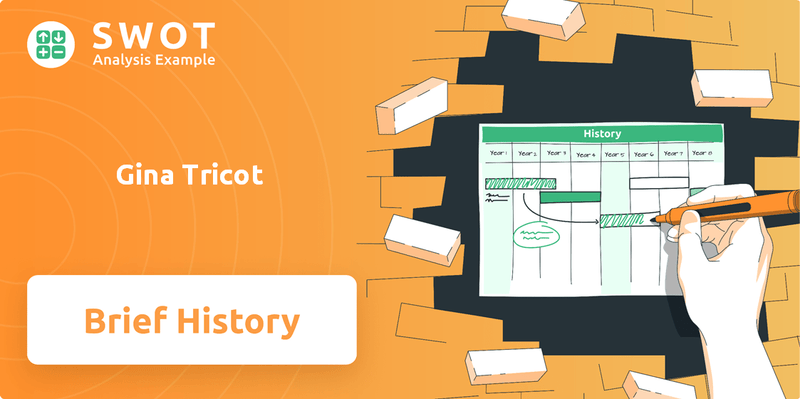
From its Swedish fashion roots, Gina Tricot has expanded rapidly, showcasing impressive growth. This brief history of Gina Tricot company details its evolution from a local retailer to a significant clothing retailer with a strong online presence. Understanding the Gina Tricot history provides valuable insights into the dynamics of the fast fashion industry and the strategies behind its success, including its expansion history and financial performance.
What is the Gina Tricot Founding Story?
The story of the Gina Tricot company began in 1997 in Borås, Sweden. Founded by Annette and Jörgen Appelqvist, the brand quickly established itself in the Swedish fashion scene. The initial concept revolved around offering accessible, fashionable clothing, setting the stage for its growth as a major clothing retailer.
The company's roots are firmly planted in Borås, a city known for its role in the Scandinavian fashion industry. This strategic location provided a supportive environment for the brand's early development. The original business model focused on a chain of stores offering trendy and affordable clothing and accessories for women. This approach helped Gina Tricot gain traction in the competitive fast fashion market.
The brand's journey started with an idea discussed at the Appelqvist family's kitchen table. The initial focus was on commercially viable and feminine tricot garments. The company's success was built on simplicity in design and operational methods. This approach aimed to offer customers a fresh and exciting shopping experience. In 2014, Nordic Capital and Frankenius Equity became co-owners, injecting new capital to bolster Gina Tricot's financial standing and support its e-commerce development.
Gina Tricot was founded in 1997 in Borås, Sweden, by Annette and Jörgen Appelqvist. The brand focused on providing affordable and fashionable clothing. The company's initial concept was developed at the Appelqvist family's kitchen table.
- The founders aimed to offer 'good fashion for little money,' focusing on commercially viable and feminine tricot garments.
- The company's early success was built on simplicity in design and operational methods.
- In 2014, Nordic Capital and Frankenius Equity joined as co-owners, strengthening the company's financial position.
- The company's growth has been marked by strategic financial management and investment. You can learn more about the Competitors Landscape of Gina Tricot.
Gina Tricot SWOT Analysis
- Complete SWOT Breakdown
- Fully Customizable
- Editable in Excel & Word
- Professional Formatting
- Investor-Ready Format
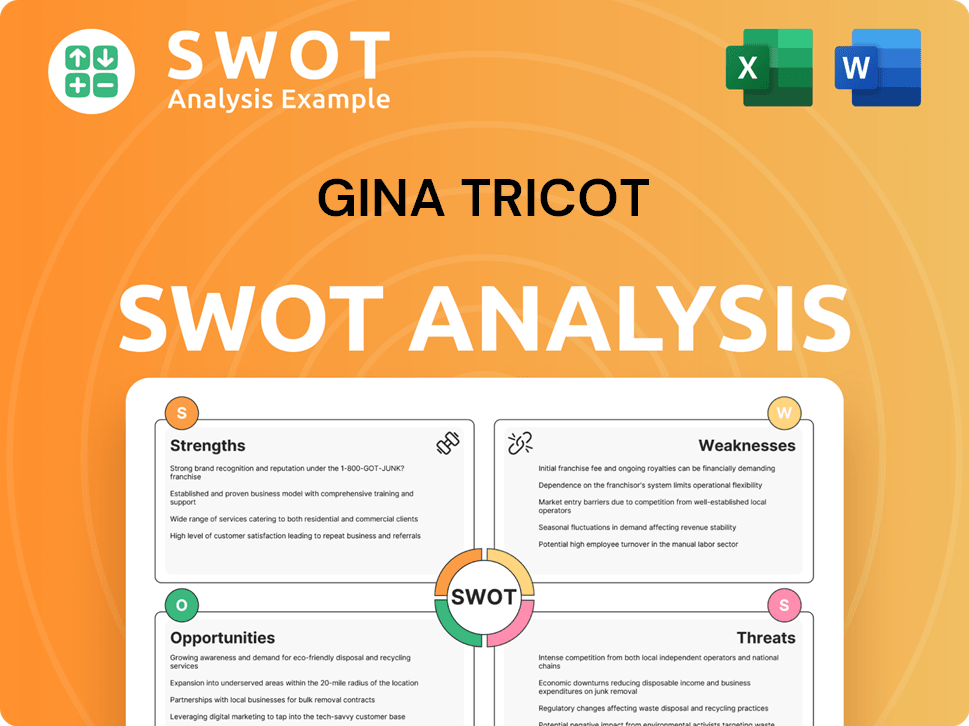
What Drove the Early Growth of Gina Tricot?
The early growth of the Gina Tricot company saw rapid expansion across the Nordic region. This Swedish fashion brand focused on providing accessible, trendy clothing, which resonated with its target demographic. By 2012, the company's annual turnover hit approximately SEK 2.5 billion, demonstrating significant early success in the competitive fast fashion market.
By 2011, the clothing retailer operated around 185 stores. These stores were spread across five countries: Sweden, Norway, Denmark, Finland, and Germany. This extensive network helped establish the brand's presence in the Nordic market.
A key development occurred in 2014 when Nordic Capital and Frankenius Equity became co-owners. This partnership was vital for developing Gina Tricot's e-commerce capabilities. The investment facilitated a new IT system and an omnichannel structure.
The investment in e-commerce led to significant growth in online sales. As of 2024, Gina Tricot's online revenue reached US$59.3 million. This demonstrates the importance of digital commerce in the company's overall strategy.
In 2015, Gina Tricot implemented a warehouse management system. The adoption of Astro WMS from Consafe Logistics improved efficiency. By October 2024, inventory accuracy reached an impressive 98% due to item-level RFID technology.
Gina Tricot PESTLE Analysis
- Covers All 6 PESTLE Categories
- No Research Needed – Save Hours of Work
- Built by Experts, Trusted by Consultants
- Instant Download, Ready to Use
- 100% Editable, Fully Customizable
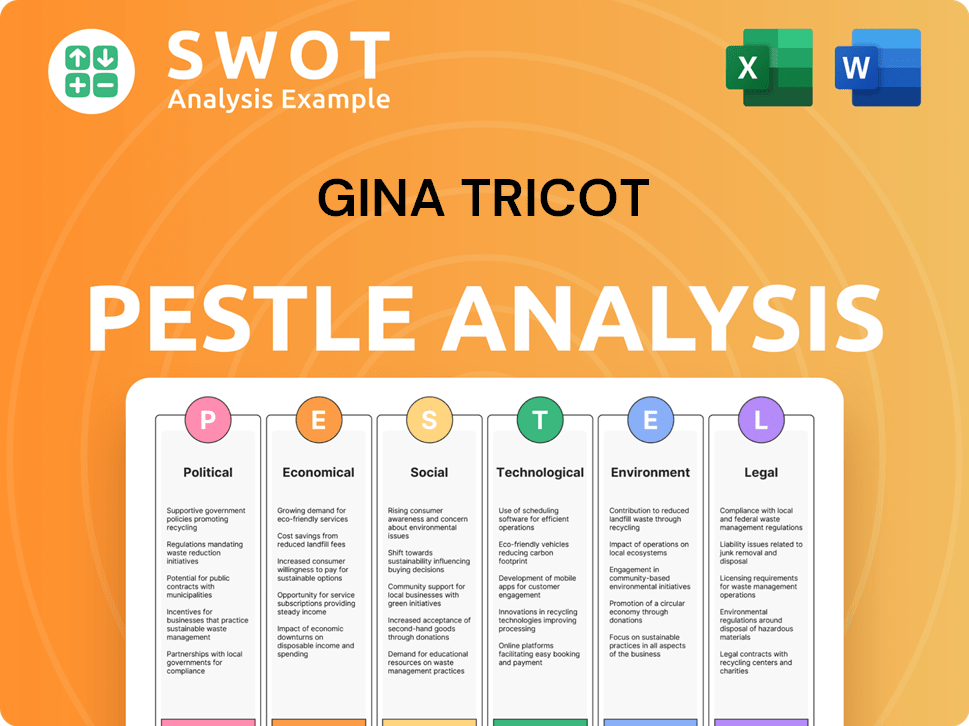
What are the key Milestones in Gina Tricot history?
The Gina Tricot company has a rich history marked by strategic shifts and significant achievements in the Swedish fashion market. Throughout its journey, the Gina Tricot brand has expanded its presence and adapted to the evolving demands of the fast fashion industry. The company's evolution reflects its commitment to innovation and sustainability, alongside its efforts to address challenges in a competitive market.
| Year | Milestone |
|---|---|
| 2014 | Investment from Nordic Capital and Frankenius Equity significantly boosted e-commerce capabilities and digital transformation. |
| 2019 | 57% of products were made from more sustainable fibers. |
| 2019 | Achieved 100% sustainable materials for all denim products. |
| 2021 | Launched 'Gina Lab', an innovation program focused on sustainable fashion methods. |
| 2021 | Partnered with ROI Hunter to optimize dynamic promotions. |
| 2023 | Launched the 'Seams Like New' denim remade collection. |
| 2024 | 77% of collections featured more sustainable fibers. |
| 2024 | 74% of Tier 1 production units operated on renewable electricity. |
| 2024 | E-commerce revenue reached US$59.3 million. |
Innovation has been a key focus for Gina Tricot, particularly in sustainability. The company has consistently increased the use of sustainable materials in its products, including the launch of initiatives like 'Gina Lab' to explore circular fashion practices. They also introduced collections like 'Seams Like New' to showcase their commitment to reducing environmental impact.
By 2019, a significant portion of their products were made from sustainable fibers. In 2024, 77% of their collections featured more sustainable fibers.
Launched in March 2021, 'Gina Lab' is an innovation program dedicated to exploring and testing sustainable fashion methods. This initiative includes exploring new technologies and materials.
In 2023, the company launched the 'Seams Like New' denim remade collection. This collection is created exclusively from reworked and reused denim from previous seasons.
By 2024, 74% of their Tier 1 production units operated on renewable electricity. This demonstrates tangible progress in their sustainability goals.
The digital business has seen rapid growth, with e-commerce revenue reaching US$59.3 million in 2024. This expansion highlights the company's successful digital transformation.
Despite its successes, Gina Tricot has faced challenges typical of the retail industry. Maintaining employee engagement, particularly with part-time and seasonal staff, has been a focus. E-commerce return rates and sustaining brand equity through cause-brand alliances have also presented difficulties. For more insights into their strategies, explore the Marketing Strategy of Gina Tricot.
The company implemented Eletive to help with employee engagement. They also developed a digital onboarding program called 'Smile Academy' through the Relesys app.
Partnering with ROI Hunter helped optimize dynamic promotions. This resulted in a 14% reduction in return rates by the peak season of 2023.
Gina Tricot has collaborated with UNICEF since 2011, focusing on education for children in Bangladesh. They have supported over 150 preschools.
The 'Smile Academy' onboarding program through the Relesys app boasts a 98% performance rate for training. This supports employee development.
The partnership with ROI Hunter increased return on ad spend (ROAS) by 11%. It also increased Google Analytics revenue by 17%.
Gina Tricot Business Model Canvas
- Complete 9-Block Business Model Canvas
- Effortlessly Communicate Your Business Strategy
- Investor-Ready BMC Format
- 100% Editable and Customizable
- Clear and Structured Layout
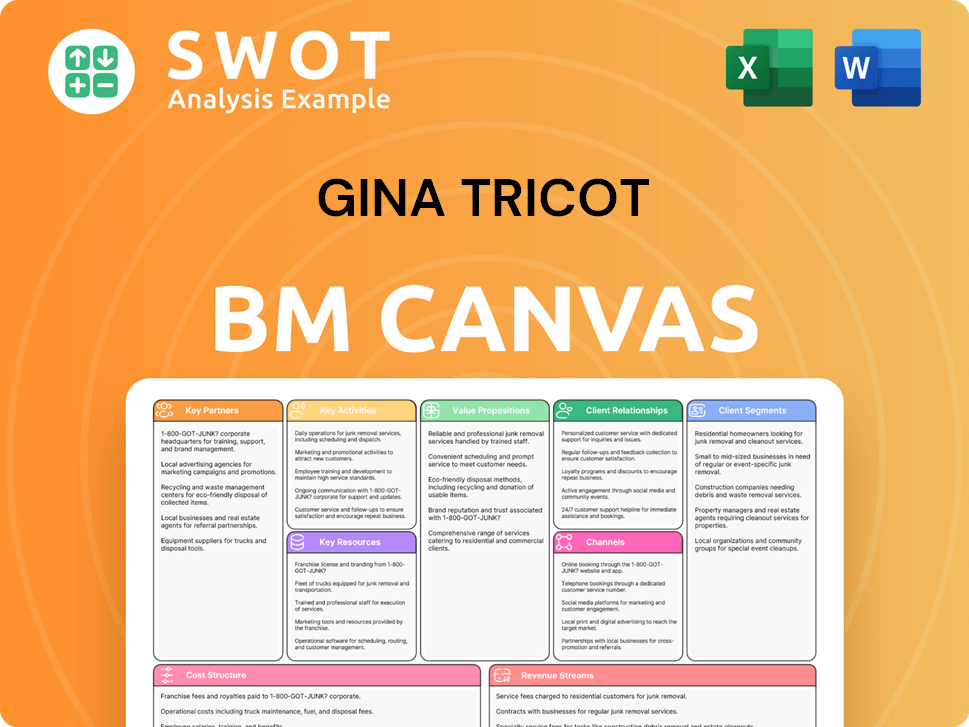
What is the Timeline of Key Events for Gina Tricot?
The Gina Tricot history showcases its evolution from a Swedish fashion startup to a prominent clothing retailer. Founded in Borås, Sweden, the company quickly expanded, adapting to market trends and consumer demands. Key milestones highlight its growth, sustainability initiatives, and strategic partnerships. The brand's journey reflects its commitment to providing accessible fashion while addressing environmental concerns.
| Year | Key Event |
|---|---|
| 1997 | Gina Tricot is founded in Borås, Sweden, by Annette and Jörgen Appelqvist, with a vision to provide trendy and affordable fashion for women. |
| 2007 | The first order for products made from organic cotton is placed, marking an early step towards sustainability. |
| 2009 | A production office is established in Bangladesh. |
| 2011 | Gina Tricot begins its collaboration with UNICEF and joins the Fur Free Retailer initiative. |
| 2012 | Gina Tricot achieves a turnover of SEK 2.5 billion, operating approximately 175 stores across five countries. |
| 2014 | Nordic Capital and Frankenius Equity become co-owners, injecting capital to strengthen the company's financial position and accelerate e-commerce development. |
| 2015 | Gina Tricot begins implementing a new warehouse management system (Astro WMS) to improve logistics and delivery efficiency for online orders. |
| 2019 | The company becomes a member of STICA and World Childhood Foundation. |
| 2020 | Gina Tricot achieves 100% more sustainable cotton in its products. |
| March 2021 | Gina Lab, an innovation program focused on sustainable and circular fashion, is launched, alongside the first Gina Lab collection. |
| July 2021 | Gina Tricot partners with ROI Hunter to enhance dynamic promotions and optimize online advertising. |
| February 2023 | The 'Seams Like New' denim remade collection is launched, emphasizing circular fashion. |
| October 2024 | Gina Tricot reports a 98% inventory accuracy since partnering with SML for item-level RFID technology. |
| 2024 | Gina Tricot makes significant progress in sustainability, with 77% of collections featuring more sustainable fibers and 74% of Tier 1 production units running on renewable electricity. |
Gina Tricot is accelerating its climate efforts, aiming to refine targets to meet evolving regulatory requirements and industry standards. Sustainability is deeply embedded across its operations, from design and production to logistics and retail. Their 'Our Planet' goals prioritize reducing emissions, expanding renewable energy use, and improving water management in their supply chain.
The company is exploring new business models, such as 'RENT', and expanding its upcycled collections to challenge customers and promote environmental and economic sustainability. This move demonstrates the brand's commitment to circular fashion and reducing its environmental footprint. Gina Tricot is also investing in innovative fibers and technologies, such as Tex2Tex™ RPET, to address polyester waste circularity challenges.
With a strong market position and increased turnover in 2024, Gina Tricot is well-positioned for continued growth. The online revenue reached US$59.3 million in 2024. The company's financial health supports its sustainability initiatives and expansion plans, ensuring long-term viability in the competitive fast-fashion market.
Gina Tricot aims to influence and inspire both the industry and its customers towards more sustainable choices. The brand continues to evolve, staying true to its founding vision of delivering fashion that is both accessible and forward-thinking. The focus remains on balancing fashion trends with environmental responsibility.
Gina Tricot Porter's Five Forces Analysis
- Covers All 5 Competitive Forces in Detail
- Structured for Consultants, Students, and Founders
- 100% Editable in Microsoft Word & Excel
- Instant Digital Download – Use Immediately
- Compatible with Mac & PC – Fully Unlocked
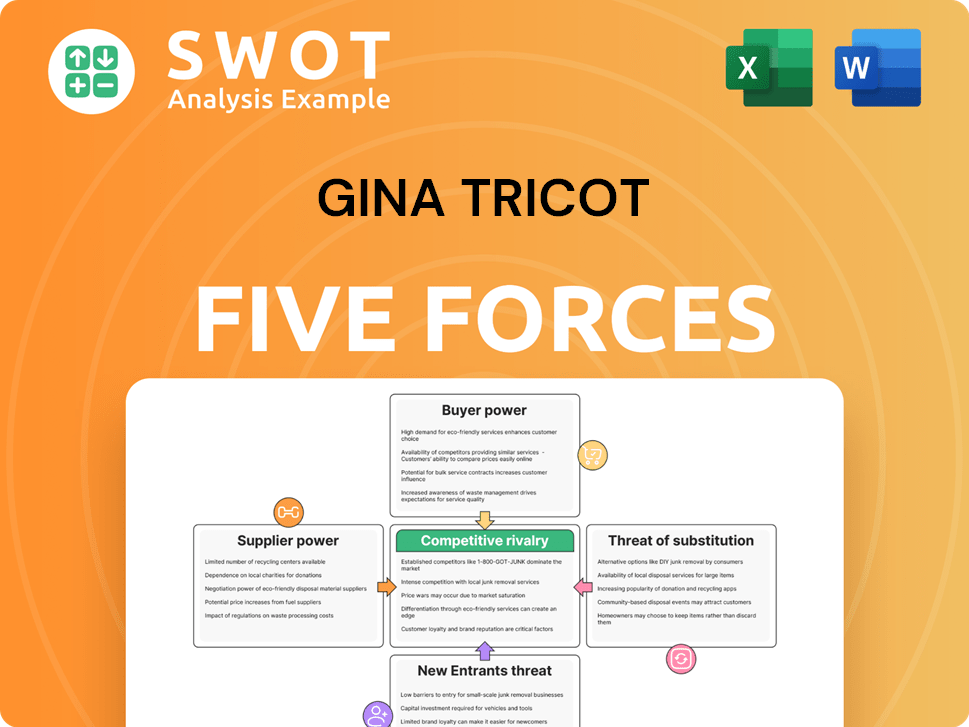
Related Blogs
- What is Competitive Landscape of Gina Tricot Company?
- What is Growth Strategy and Future Prospects of Gina Tricot Company?
- How Does Gina Tricot Company Work?
- What is Sales and Marketing Strategy of Gina Tricot Company?
- What is Brief History of Gina Tricot Company?
- Who Owns Gina Tricot Company?
- What is Customer Demographics and Target Market of Gina Tricot Company?
Disclaimer
All information, articles, and product details provided on this website are for general informational and educational purposes only. We do not claim any ownership over, nor do we intend to infringe upon, any trademarks, copyrights, logos, brand names, or other intellectual property mentioned or depicted on this site. Such intellectual property remains the property of its respective owners, and any references here are made solely for identification or informational purposes, without implying any affiliation, endorsement, or partnership.
We make no representations or warranties, express or implied, regarding the accuracy, completeness, or suitability of any content or products presented. Nothing on this website should be construed as legal, tax, investment, financial, medical, or other professional advice. In addition, no part of this site—including articles or product references—constitutes a solicitation, recommendation, endorsement, advertisement, or offer to buy or sell any securities, franchises, or other financial instruments, particularly in jurisdictions where such activity would be unlawful.
All content is of a general nature and may not address the specific circumstances of any individual or entity. It is not a substitute for professional advice or services. Any actions you take based on the information provided here are strictly at your own risk. You accept full responsibility for any decisions or outcomes arising from your use of this website and agree to release us from any liability in connection with your use of, or reliance upon, the content or products found herein.